🫑 Gourds
Cultivation, Important Points
Bottle Gourd
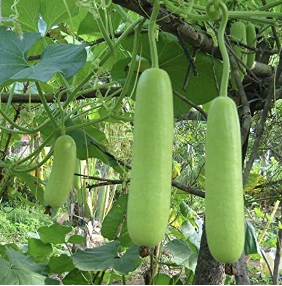
- Botanical Name: Lagenaria siceraria
- Family: Cucurbitaceae
- Origin: South Africa
- Known as “lauki”
- Seed rate: 3-6 kg/ha
- Kofta and Petha are most popular preparations from Bottle gourd.
- It is highly sensitive to photoperiod.
- Dry shell is used for preparation of musical instrument.

- Processed product - tooty-fruity.

- Fruit pulp is very good source of fibre free carbohydrates. (Diabetes)
- Germination: 25-30°C, Brownish or whitish brown seeds germinate well.
- High temperature and High N2 induce maleness in Bottle gourd.
- Heterosis is present through its life cycle in all stages.
Varieties
- Selection
- Pusa Summer Prolific long
- Pusa Summer Prolific round
- Arka Bahar
- Pusa Naveen
- Punjab Round
- Punjab long
- Samrat: Highest Yield
- Hybrid
- Punjab Komal
- Pusa Mangan
Pusa Meghdoot: 1st F1 hybrid by public sector.- Gutka
- Harit
- Varad
- NDBG-1: Diara
- PBO G-1: for Northern Plains
- Pusa sandesh - New variety
Bitter Gourd
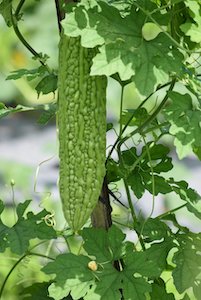
- Botanical Name:
Momordica charantia - Family: Cucurbitaceae
- Origin: Indo-Burma
- Bitter principle:
Momordicin - Immature, tender fruits are harvested.
- Bitter gourd fruits are rich in iron.
- If temperature goes above 40°C, induces maleness.
- Sowing Time: Jan-Feb: in North East India.
- Fruits ready in 60-70 DAS.
Varieties
- Selection
- Pusa-Do-Mausami
- Coimbatore long
- Priyanka
- Harkani
Pusa VisheshArka Harit- Preethi
- Konkan Tara — Suitable for export
- Hybrid
- Phule Green Gold: Green long x Delhi local
- Pusa hybrid-I
Summer Squash

- Botanical Name:
Cucurbita pepo - Family: Cucurbitaceae
- Origin: Mexico
- Harvesting stage: At 1/3rd maturity
- It is also known as bushy cucurbit, ornamental cucurbits.
- Introduced variety:
- Patty Pan
- Australian Green
- Selection:
- Early yellow Prolific
- F1 Hybrid: Pusa Alankar: Chappan x Early yellow prolific
Snake Gourd
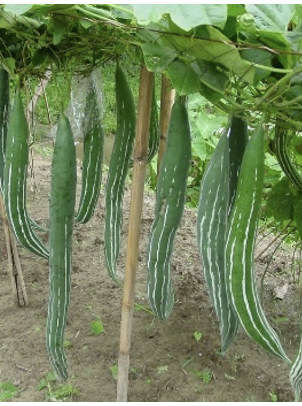
- Botanical Name:
Trichosanthes anguina - Family: Cucurbitaceae
- Origin: India
- Bower system of training is best for it.
- Variety:
- Konkan Shweta
- Winter Squash - Vilayati Kaddu
- Arka Suryamukhi, Pink Banana
Pointed Gourd
- Botanical Name: Trichosandhus dioca
- Family: Cucurbitaceae
- Origin: India
- Propagation by vine cutting @ 2000-2500 cuttings/hac.
- Fruits are particularly recommended during convalescence (Regains health after illness).
- 10% male plant is necessary to get high yield.
- Varieties
- Bihar Sherif
- Kalyani
- Shankolia
- Swarna Rekha
- Dandli
- Damodar
- Swarna Alaukik
- Chhota Hilli
Ash Gourd
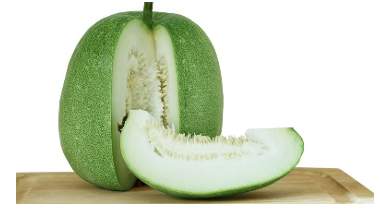
- Botanical Name: Benincasa hispida
- Family: Cucurbitaceae
- Origin: Japan
- Fruits at maturity have white waxy surface.
- Annual hipsid (Rough with bristle like hairs).
- It is also known as Chinese preserving melon.
- Longest storage life, among cucurbits.
- Variety
- Mudlier
- Pusa Ujjwal
Chow-Chow
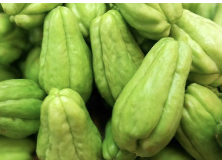
- Botanical Name: Sechium edule
- Family: Cucurbitaceae
- Origin: Mexico
- Single seeded fruit in cucurbits.
- Most nutritious among cucurbits.
- Herbaceous, perennial, monoecious, climbing vine.
- Common name: Chayote, Choco, Askas
- High Calcium content.
- Propagation: By fruits (Vivipary)
- Spine Gourd (Kakrol)
- Dioecious
- Propagation by tuberous roots
Ridge Gourd

- Botanical Name: Luffa acutangula
- Family: Cucurbitaceae
- Origin: Asia
- Commercially trained on kniffin system.
- Used in Bathing Sponge.
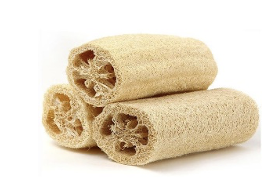
Varieties
Pusa Nasdar: Hermaphrodite variety- Satputia: Hermaphrodite variety
- Konkan Harita
- Punjab Sadabahar
- Hybrid
- Surekha
- Arka Sujat
Sponge Gourd
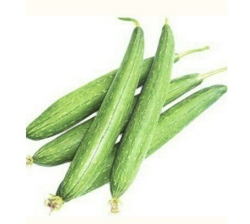
- Botanical Name:
Luffa cylindrica - Family: Cucurbitaceae
- Origin: Asia
- Sponge Gourd contains higher protein and carotene than ridge gourd.
- Both Luffa spp. contain, a gelatinous compound called – luffien
- Fruits are harvested at tender stage.
- Anthesis: 4-8 am (morning).
Varieties
Pusa Chikni: Selection and early variety- Pusa Supriya
- Phule prajakta
- Harita: F1 hybrid
Disease in Cucurbits
- Powdery mildew in cucurbits due to
Erysiphe cichoracearum - Downey mildew in cucurbits due to
Pseudoperanospora cubensis - Yellow vine of cucurbits is due to
Serratia marcescens - Bud necrosis: mostly in water melon, viral, transmitted by
Aphids.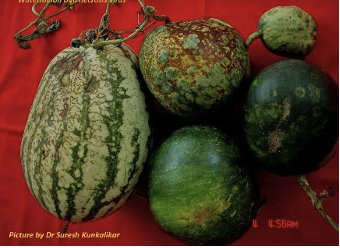
Insect-pests of cucurbits
- Red pumpkin beetle:
Raphidopalpa foeicollis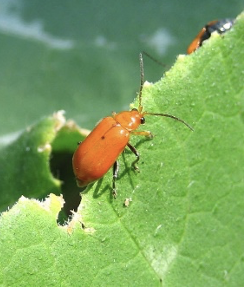
- Both grub and adult beetle cause damage, the grub damage the plants by boring in to roots and underground stem.
- But beetle are very destructive to vegetable particularly March-April when creepers are very young.
- Management:
- Apply Carbofuran 3 g @ 7.0 kg/ha or Methyl parathion 2% dust @ 20 kg/ha.
- Spray Malathion 50 EC @ 0.05 %.
- Cucurbits fruit flies:
Bactrocera cucurbitae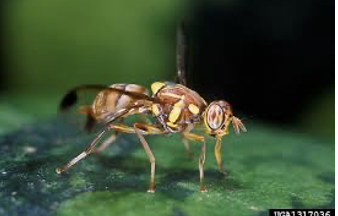
- Maggots feed pulp and seeds infested fruits may fall prematurely & fruit become soft and rotten.
- It can be controlled by bait spray containing 50 ml of Malathion 35 EC and 0.5 kg Gur/molasses in 50 liters of water for one ha.
- Cucurbit mite:
Tetranychus cucurbitae
- Known as red spider mite
- Suck cell sap by making webbing on underside of leaves
- Damage confined to under surface of leaves
- It controlled by Dicofol/ Ethion 50 EC @ 1.5 ml/liter
Bottle Gourd

- Botanical Name: Lagenaria siceraria
- Family: Cucurbitaceae
- Origin: South Africa
- Known as “lauki”
- Seed rate: 3-6 kg/ha
- Kofta and Petha are most popular preparations from Bottle gourd.
- It is highly sensitive to photoperiod.
- Dry shell is used for preparation of musical instrument.

- Processed product - tooty-fruity.

- Fruit pulp is very good source of fibre free carbohydrates. (Diabetes)
- Germination: 25-30°C, Brownish or whitish brown seeds germinate well.
- High temperature and High N2 induce maleness in Bottle gourd.
- Heterosis is present through its life cycle in all stages.
Varieties
- Selection
- Pusa Summer Prolific long
- Pusa Summer Prolific round
- Arka Bahar
- Pusa Naveen
- Punjab Round
- Punjab long
- Samrat: Highest Yield
- Hybrid
- Punjab Komal
- Pusa Mangan
Pusa Meghdoot: 1st …
Become Successful With AgriDots
Learn the essential skills for getting a seat in the Exam with
🦄 You are a pro member!
Only use this page if purchasing a gift or enterprise account
Plan
Rs
- Unlimited access to PRO courses
- Quizzes with hand-picked meme prizes
- Invite to private Discord chat
- Free Sticker emailed
Lifetime
Rs
1,499
once
- All PRO-tier benefits
- Single payment, lifetime access
- 4,200 bonus xp points
- Next Level
T-shirt shipped worldwide

Yo! You just found a 20% discount using 👉 EASTEREGG

High-quality fitted cotton shirt produced by Next Level Apparel